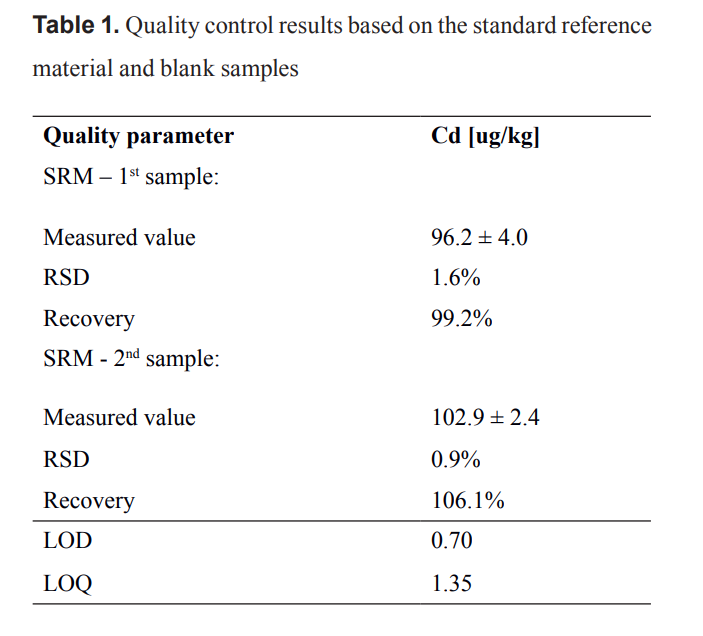Cadmium in pork and poultry liver in southern Poland
DOI:
https://doi.org/10.5604/01.3001.0012.7715Słowa kluczowe:
atomic absorption, animal liver, cadmiumAbstrakt
Samples of pork and poultry livers (ten samples of each type, purchased in southern Poland) were analyzed in order to determine the cadmium concentration. Wet digestion of the samples was carried out and the concentration of cadmium was measured by means of graphite-furnace atomic absorption spectrometry (GF-AAS). The mean values for pork and poultry livers were 79.3 µg/kg and 165.3 µg/kg, respectively. In one sample of poultry liver the Cd concentration was 1043 µg/kg, which is much more than the legal limit for the European Union (500 µg/kg). Statistical analysis showed that there was no significant difference in Cd concentration between the two groups of the samples, unless the highest result (1043 µg/kg) was considered an outlier.
Statystyka pobrań
Bibliografia
Hutton M. Human Health Concerns of Lead, Mercury, Cadmium and Arsenic. In: Lead, Mercury, Cadmium and Arsenic in the Environment. 1987, 53–68. Google Scholar
European Commission. Commission Regulation (EC) no 1881/2006: setting maximum levels for certain contaminants in foodstuffs. Off J Eur Union. 2006; (1881):5–24. Google Scholar
WHO – World Health Organization. Evaluation of certain food additive and contaminants. World Health Organ Tech Rep Ser. 2011; 960:162–77. Google Scholar
Bampidis VA, Nistor E, Nitas D. Arsenic, Cadmium, Lead and Mercury as Undesirable Substances in Animal Feeds. Anim Sci Biotechnol. 2013; 46(1):17–22. Google Scholar
Ping Zhuang, Bi Zou, Huanping Lu ZL. Heavy Metal Concentrations in Five Tissues of Chickens from a Mining Area. Pol J Environ Stud. 2014; 23(6):2375–9. Google Scholar
Central Statistical Office P. Statistical Yearbook of Agriculture. 2016. Google Scholar
Costa RG, Bah HAF, Bandeira MJ, Oliveira SSP, Menezes-Filho JA. Lead and cadmium in mangrove root crab (Goniopsis cruentata), in natura and at food processing stages. Food Addit Contam Part B. 2017; 10(3):216–21. Google Scholar
Rudy M. Correlation of lead, cadmium and mercury levels in tissue and liver samples with age in cattle. Food Addit Contam – Part A Chem Anal Control Expo Risk Assess. 2009; 26(6):847–53. Google Scholar
Serpe FP, Russo R, Simone A de, Florio S, Esposito M, Severino L. Levels of heavy metals in liver and kidney of dogs from urban environment. Open Vet J. 2012; 2:15–8. Google Scholar
Tahvonen R, Kumpulainen J. Lead and cadmium contents in pork, beef and chicken, and in pig and cow liver in Finland during 1991. Food Addit Contam. 1994; 11(4):415–426. Google Scholar
Taylor BN, Kuyatt CE. Guidelines for Evaluating and Expressing the Uncertainty of NIST Measurement Results. Vol. 1297, NIST Technical Note. 1994. Google Scholar
Zasadowski A, Barski D, Markiewicz K, Zasadowski Z, Spodniewska A, Terlecka A. Levels of Cadmium Contamination of Domestic Animals (Cattle) in the Region of Warmia and Masuria. Polish J Environ Stud. 1999; 8(6):443–6. Google Scholar
Adei E, Forson-Adaboh K. Toxic (Pb, Cd, Hg) and essential (Fe, Cu, Zn, Mn) metal content of liver tissue of some domestic and bush animals in ghana. Food Addit Contam Part B Surveill. 2008; 1(2):100–5. Google Scholar
Kim D-G, Kim M, Shin JY, Son S-W. Cadmium and lead in animal tissue (muscle, liver and kidney), cow milk and dairy products in Korea. Food Addit Contam Part B. 2016; 9(1):33–7. Google Scholar
Kramárová M, Massányi P, Slamecka J, Tataruch F, Jancová A, Gasparik J, et al. Distribution of cadmium and lead in liver and kidney of some wild animals in Slovakia. J Environ Sci Heal – Part A Toxic/Hazardous Subst Environ Eng. 2005; 40(3):593–600. Google Scholar

Pobrania
Opublikowane
Jak cytować
Numer
Dział
Licencja
Prawa autorskie (c) 2018 Państwowa Wyższa Szkoła Zawodowa w Tarnowie & Autorzy

Utwór dostępny jest na licencji Creative Commons Uznanie autorstwa – Użycie niekomercyjne 4.0 Międzynarodowe.



